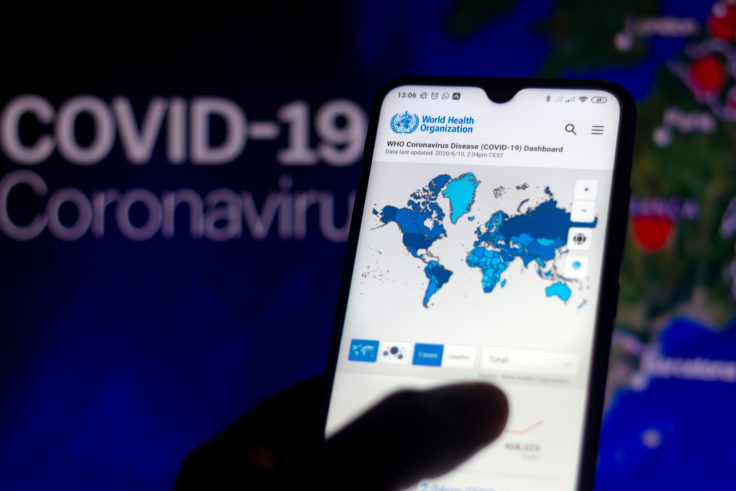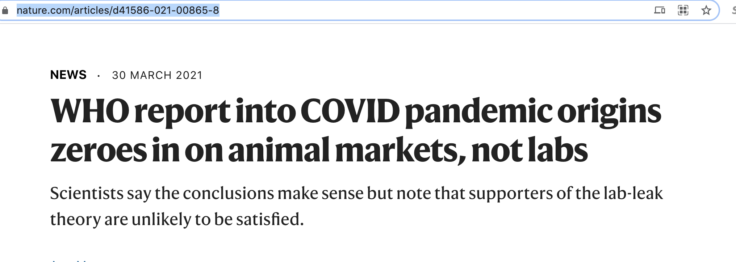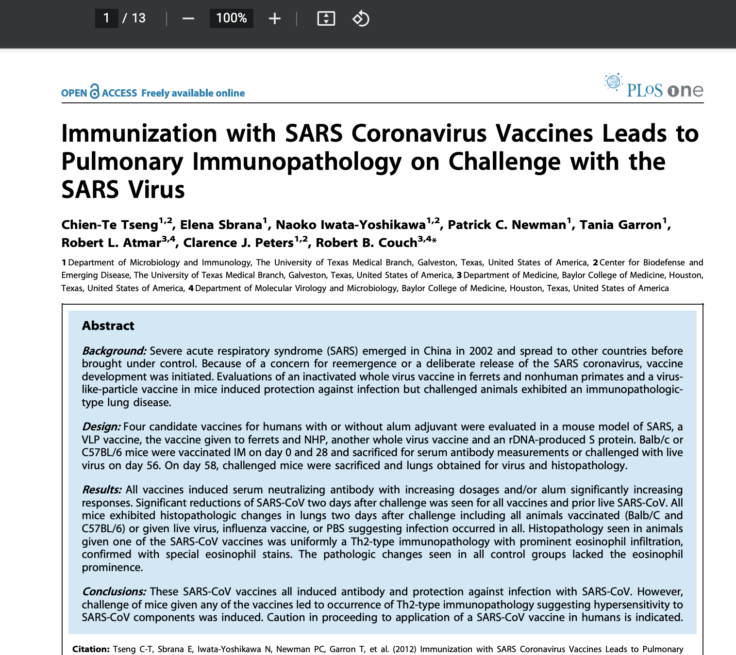NewsRescue
While the 2020 SARS Coronavirus pandemic (COVID-19) pandemic, and the global vaccine development remedy appeared recent novel and unexpected events, a study from 2012 suggests otherwise.
The study, captioned “Immunization with SARS Coronavirus Vaccines Leads to Pulmonary Immunopathology on Challenge with the SARS Virus” by Chien-Te Tseng et al, published in PLOS one in April of 2012, was prompted according to its authors, on the basis of a fear that certain unscrupulous individuals might deliberately release the SARS coronavirus as an attack on the human race.

The prospects of COVID-19 having been deliberately released is one that the World Health Organisation has been quick to dismiss.

2012 SARS Coronavirus Vaccines Triggered Lung Pathology
Various vaccines for the SARS coronavirus were developed by the team in 2012 and experimented in animals with all tests including the use of inactivated virus and virus-like particles, resulting in adverse lung pathology. This was attributed to Th2 immunopathology, in which a faulty T cell response triggers allergic inflammatory lung disease.
The study abstract and link are below:
https://www.ncbi.nlm.nih.gov/pmc/articles/PMC3335060/pdf/pone.0035421.pdf
Abstract
Background: Severe acute respiratory syndrome (SARS) emerged in China in 2002 and spread to other countries before brought under control. Because of a concern for reemergence or a deliberate release of the SARS coronavirus, vaccine development was initiated. Evaluations of an inactivated whole virus vaccine in ferrets and nonhuman primates and a virus like-particle vaccine in mice induced protection against infection but challenged animals exhibited an immunopathologic type lung disease.
Design: Four candidate vaccines for humans with or without alum adjuvant were evaluated in a mouse model of SARS, a VLP vaccine, the vaccine given to ferrets and NHP, another whole virus vaccine and an rDNA-produced S protein. Balb/c or C57BL/6 mice were vaccinated IM on day 0 and 28 and sacrificed for serum antibody measurements or challenged with live virus on day 56. On day 58, challenged mice were sacrificed and lungs obtained for virus and histopathology.
Results: All vaccines induced serum neutralizing antibody with increasing dosages and/or alum significantly increasing responses. Significant reductions of SARS-CoV two days after challenge was seen for all vaccines and prior live SARS-CoV. All mice exhibited histopathologic changes in lungs two days after challenge including all animals vaccinated (Balb/C and
C57BL/6) or given live virus, influenza vaccine, or PBS suggesting infection occurred in all. Histopathology seen in animals given one of the SARS-CoV vaccines was uniformly a Th2-type immunopathology with prominent eosinophil infiltration, confirmed with special eosinophil stains. The pathologic changes seen in all control groups lacked the eosinophil
prominence.
Conclusions: These SARS-CoV vaccines all induced antibody and protection against infection with SARS-CoV. However, challenge of mice given any of the vaccines led to occurrence of Th2-type immunopathology suggesting hypersensitivity to SARS-CoV components was induced. Caution in proceeding to application of a SARS-CoV vaccine in humans is indicated.

This finding is discussed in a recent review, published under title, “Immunological considerations for COVID-19 vaccine strategies” by Mangalakumari Jeyanath et al, in Nature, October 2020. Excerpt:
“Studies with inactivated SARS-CoV and respiratory syncytial virus vaccines have reported vaccine-related enhancement of disease, likely involving a TH2 cell response and lung eosinophilia, which may be worsened in aged hosts”
The adverse effect risks are also discussed here: https://www.pnas.org/content/117/15/8218
The Pfizer and Moderna Covid vaccines use new mRNA technology to invoke responses to the spike protein of the coronavirus.
Related: Herpes zoster reactivation — a.k.a. shingles reported as aide effect of COVID-19 vaccines




